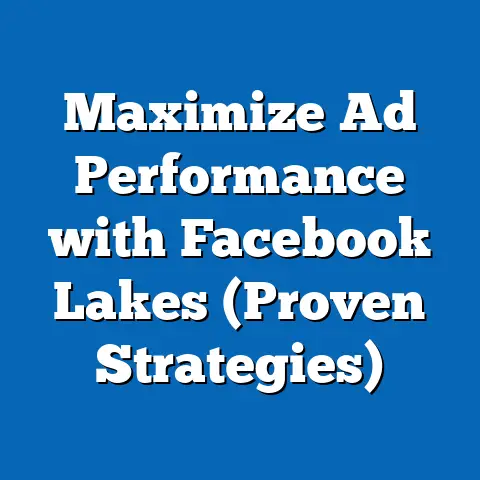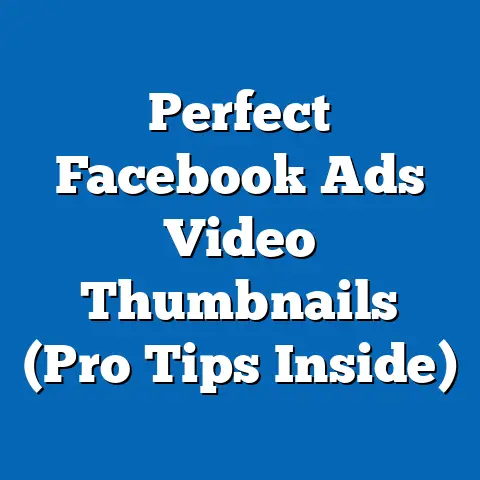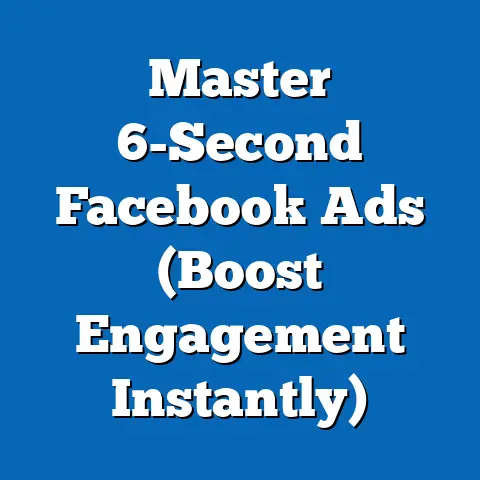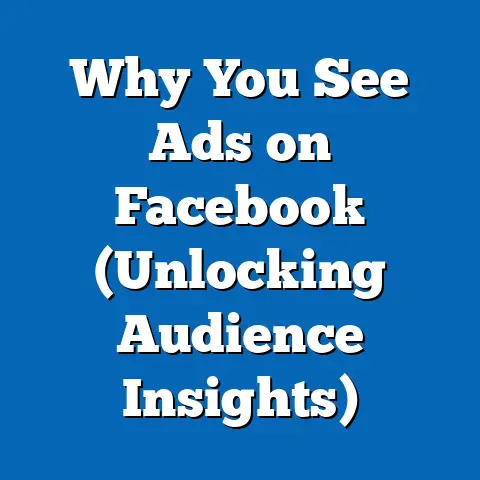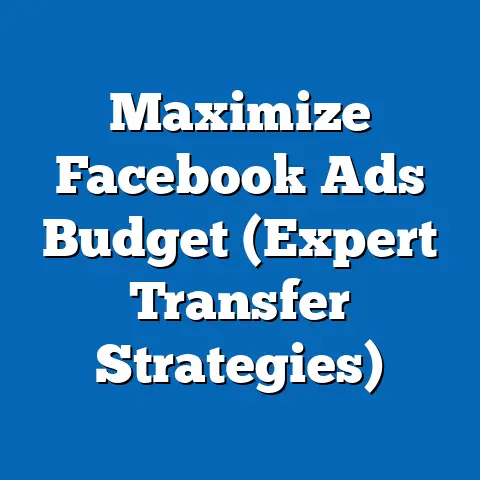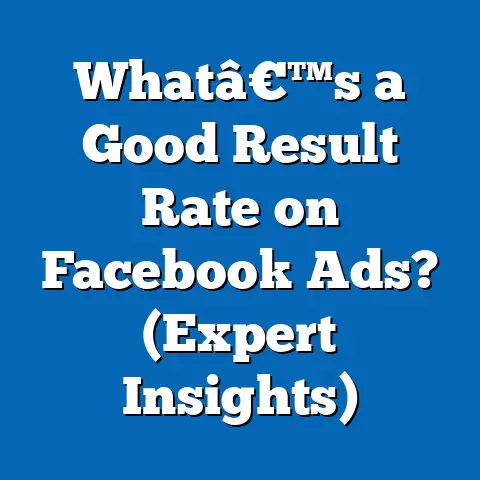Facebook Ads vs Google Ads: Who Converts Better? (Data-Driven Insights)
It’s a common pitfall I see marketers stumble into all the time: assuming that one advertising platform, either Facebook Ads or Google Ads, is inherently superior for conversions. I’ve been there myself, initially favoring the detailed targeting of Facebook, only to realize that for certain campaigns, Google’s laser focus on search intent was the winning ticket. The truth is, blindly choosing a platform based on assumptions can lead to wasted ad spend and missed opportunities. According to a recent study by HubSpot, businesses that align their ad strategies with specific campaign goals see up to a 30% increase in conversion rates. That’s why a data-driven approach is crucial when deciding where to allocate your marketing budget. Let’s dive into a comprehensive comparison of Facebook Ads and Google Ads to determine which platform truly converts better and why.
Understanding the Platforms
Before we delve into the data, it’s essential to understand the fundamental differences between Facebook Ads and Google Ads. Both platforms are powerful, but they cater to different user behaviors and offer unique targeting capabilities.
Overview of Facebook Ads
Facebook, now under the Meta umbrella, boasts a massive user base of over 2.9 billion monthly active users worldwide (Statista, 2024). This sheer scale makes it a fertile ground for reaching a diverse range of audiences. Facebook Ads shine when it comes to granular targeting. I’ve personally used it to target users based on demographics, interests, behaviors, and even life events.
How Facebook Ads Work:
- Targeting Options: Facebook’s strength lies in its ability to target users based on a wealth of data. You can define your audience by age, gender, location, education, relationship status, interests, hobbies, and much more. Custom Audiences allow you to upload your own customer data or create lookalike audiences based on your existing customer base.
- Ad Formats: Facebook offers a variety of ad formats, including image ads, video ads, carousel ads, collection ads, and lead generation ads. This flexibility allows you to choose the format that best showcases your product or service.
- Placement Strategies: Facebook Ads can be displayed across Facebook, Instagram, Messenger, and the Audience Network, giving you broad reach across multiple touchpoints. The platform’s AI-powered ad delivery system optimizes ad placement to maximize performance.
Overview of Google Ads
Google Ads, on the other hand, leverages the power of search intent. With over 3.5 billion searches performed on Google every day (Internet Live Stats, 2024), the platform allows you to reach users who are actively looking for information, products, or services.
How Google Ads Work:
-
Click-Through Rate (CTR): This metric measures the percentage of people who click on your ad after seeing it. A high CTR indicates that your ad is relevant and engaging to your target audience.
- Importance: CTR is a good indicator of ad relevance and quality.
- Interpretation: A higher CTR generally indicates a more compelling ad.
- Relationship to Other Metrics: CTR influences Quality Score in Google Ads and relevance score in Facebook Ads, both of which impact ad costs and placement.
-
Conversion Rate: This metric measures the percentage of people who complete a desired action (e.g., purchase, sign-up, lead submission) after clicking on your ad.
-
Importance: Conversion Rate directly measures the effectiveness of turning ad clicks into desired outcomes.
- Interpretation: A high conversion rate indicates that your landing page is effective in persuading visitors to take action.
- Relationship to Other Metrics: Conversion Rate is inversely related to Cost Per Conversion (CPA).
-
Cost Per Conversion (CPA): This metric measures the average cost of acquiring a conversion.
-
Importance: CPA helps you understand the efficiency of your advertising spend.
- Interpretation: A lower CPA indicates that you are acquiring conversions at a lower cost.
- Relationship to Other Metrics: CPA is influenced by both the cost per click (CPC) and the conversion rate.
-
Return on Ad Spend (ROAS): This metric measures the revenue generated for every dollar spent on advertising.
-
Importance: ROAS provides a comprehensive view of the profitability of your advertising campaigns.
- Interpretation: A higher ROAS indicates that your advertising campaigns are generating a strong return on investment.
- Relationship to Other Metrics: ROAS takes into account both the revenue generated and the cost of advertising, providing a holistic view of campaign performance.
Click-Through Rate (CTR): This metric measures the percentage of people who click on your ad after seeing it. A high CTR indicates that your ad is relevant and engaging to your target audience.
- Importance: CTR is a good indicator of ad relevance and quality.
- Interpretation: A higher CTR generally indicates a more compelling ad.
- Relationship to Other Metrics: CTR influences Quality Score in Google Ads and relevance score in Facebook Ads, both of which impact ad costs and placement.
-
Conversion Rate: This metric measures the percentage of people who complete a desired action (e.g., purchase, sign-up, lead submission) after clicking on your ad.
-
Importance: Conversion Rate directly measures the effectiveness of turning ad clicks into desired outcomes.
- Interpretation: A high conversion rate indicates that your landing page is effective in persuading visitors to take action.
- Relationship to Other Metrics: Conversion Rate is inversely related to Cost Per Conversion (CPA).
-
Cost Per Conversion (CPA): This metric measures the average cost of acquiring a conversion.
-
Importance: CPA helps you understand the efficiency of your advertising spend.
- Interpretation: A lower CPA indicates that you are acquiring conversions at a lower cost.
- Relationship to Other Metrics: CPA is influenced by both the cost per click (CPC) and the conversion rate.
-
Return on Ad Spend (ROAS): This metric measures the revenue generated for every dollar spent on advertising.
-
Importance: ROAS provides a comprehensive view of the profitability of your advertising campaigns.
- Interpretation: A higher ROAS indicates that your advertising campaigns are generating a strong return on investment.
- Relationship to Other Metrics: ROAS takes into account both the revenue generated and the cost of advertising, providing a holistic view of campaign performance.
Conversion Rate: This metric measures the percentage of people who complete a desired action (e.g., purchase, sign-up, lead submission) after clicking on your ad.
Importance: Conversion Rate directly measures the effectiveness of turning ad clicks into desired outcomes.
Cost Per Conversion (CPA): This metric measures the average cost of acquiring a conversion.
Importance: CPA helps you understand the efficiency of your advertising spend.
Return on Ad Spend (ROAS): This metric measures the revenue generated for every dollar spent on advertising.
Importance: ROAS provides a comprehensive view of the profitability of your advertising campaigns.
It’s crucial to align these metrics with your overall business goals. For example, if your goal is to generate leads, you should focus on optimizing your campaigns for lead generation and tracking the cost per lead (CPL).
Data-Driven Comparison
Now, let’s dive into the data to see how Facebook Ads and Google Ads stack up in terms of conversion performance.
Case Studies on Facebook Ads Performance
Facebook Ads can be highly effective for driving conversions, especially when targeting specific audiences with engaging ad creatives. Here are a few case studies to illustrate this:
- E-commerce: A study by Shopify found that Facebook Ads can generate an average conversion rate of 1.84% for e-commerce businesses (Shopify, 2024). I’ve personally seen even higher conversion rates when using retargeting campaigns to reach users who have previously visited a website or added items to their cart.
- Lead Generation: A report by HubSpot found that Facebook Ads can generate leads at a cost of $18.72 per lead, which is significantly lower than other channels (HubSpot, 2024). I’ve had success using lead generation ads to collect contact information from users directly on Facebook, making it easy for them to sign up for newsletters or request more information.
- App Installs: Facebook Ads are also effective for driving app installs. A study by AppsFlyer found that Facebook Ads can generate app installs at a cost of $2.00 per install, which is competitive with other app advertising platforms (AppsFlyer, 2024).
Case Studies on Google Ads Performance
Google Ads, with its focus on search intent, can also deliver strong conversion results. Here are some case studies to consider:
- E-commerce: A study by WordStream found that Google Ads can generate an average conversion rate of 3.17% for e-commerce businesses (WordStream, 2024). This is higher than the average conversion rate for Facebook Ads, suggesting that Google Ads may be more effective for driving sales.
- Local Businesses: Google Ads are particularly effective for local businesses. A report by BrightLocal found that 76% of people who search for a local business on Google visit it within 24 hours (BrightLocal, 2024). This highlights the importance of Google Ads for driving foot traffic to brick-and-mortar stores.
- B2B: Google Ads can also be effective for B2B businesses. A study by MarketingProfs found that 80% of B2B purchase decisions start with a search engine query (MarketingProfs, 2024). This underscores the importance of Google Ads for reaching potential B2B customers.
Industry-Specific Insights
The performance of Facebook Ads and Google Ads can vary significantly across different industries. Here are some insights to consider:
- E-commerce: Google Ads often outperform Facebook Ads in terms of conversion rates for e-commerce businesses. This is because Google Ads target users who are actively searching for products, while Facebook Ads target users based on interests and behaviors.
- B2B: Google Ads can be effective for B2B businesses, but Facebook Ads can also play a role in building brand awareness and generating leads.
- Local Businesses: Google Ads are essential for local businesses, but Facebook Ads can also be used to target local customers with special offers and promotions.
Audience Intent and Engagement
The difference in user intent between Facebook and Google is a critical factor in determining which platform is better for conversions.
Google Ads: Capturing Demand
Google Ads often capture demand when users are actively searching for solutions. When someone types “best running shoes” into Google, they are clearly looking to buy running shoes. Google Ads allows you to target these users with ads that directly address their search query, leading to potentially higher conversion rates.
Facebook Ads: Creating Demand
Facebook, on the other hand, excels at creating demand. Users on Facebook are often in a more passive browsing state, scrolling through their newsfeeds and engaging with content from friends and family. Facebook Ads allows you to target these users with engaging ads that pique their interest and create a desire for your product or service.
I’ve seen this firsthand when running ads for a local bakery. Google Ads were effective for capturing customers who were actively searching for “bakery near me,” while Facebook Ads were effective for reaching local residents with mouthwatering photos of the bakery’s pastries, enticing them to visit even if they weren’t actively looking for a bakery.
Cost Analysis
The cost of advertising on Facebook and Google can vary depending on a number of factors, including industry, targeting options, and ad quality.
- Cost Per Click (CPC): The average CPC on Facebook Ads is $0.97, while the average CPC on Google Ads is $2.69 (WebFX, 2024). This suggests that Facebook Ads can be a more cost-effective option for driving traffic to your website.
- Cost Per Acquisition (CPA): The average CPA on Facebook Ads is $18.72, while the average CPA on Google Ads is $48.96 (HubSpot, 2024). This further supports the idea that Facebook Ads can be more cost-effective for generating leads and conversions.
However, it’s important to note that these are just averages. The actual cost of advertising on Facebook and Google can vary significantly depending on your specific circumstances.
Budget allocation can also affect overall conversions and the efficiency of ad spend. It’s crucial to test different budget levels and monitor the performance of your campaigns to determine the optimal budget allocation for each platform.
Conclusion
So, who converts better: Facebook Ads or Google Ads? The answer, as I’ve discovered time and again, isn’t a simple one. It depends on your specific business goals, target audience, and the nature of your product or service.
- Facebook Ads: Excellent for building brand awareness, targeting specific audiences, and creating demand for your product or service.
- Google Ads: Ideal for capturing demand from users who are actively searching for solutions, driving traffic to your website, and generating sales.
The key takeaway is that the choice between Facebook Ads and Google Ads should be driven by data and aligned with your specific marketing goals. Don’t rely on assumptions or trends. Instead, analyze your own advertising data, test different strategies, and continuously optimize your campaigns for maximum performance.
Call to Action
I encourage you to take a data-driven approach to your advertising strategy. Analyze your own advertising data, consider both Facebook Ads and Google Ads, and continuously optimize your campaigns for maximum performance. By doing so, you can unlock the full potential of these powerful advertising platforms and achieve your business goals.

